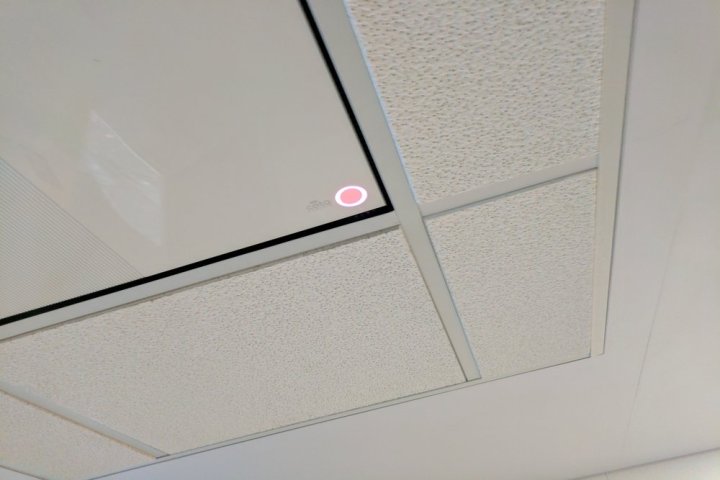
The Cota, for the unintiated, is a somewhat nebulous term for Ossia’s wireless charging technology. It comprises a transmitter, a receiver, and software to manage it all. The transmitter, which comes in form factors ranging from an illuminated monolithic white cylinder to a drop ceiling tile, charges Cota-compatible devices using hundreds of omnidirectional antennas that beam radio (RF) waves 100 times a second.
They receivers lie mostly dormant, triggered only when a Cota-compatible receiver sends a packet of information indicating it’s low on power. The Cota then directs the needed energy to the transceiver’s relative location, or to multiple transceivers’ locations. The devices needn’t be stationary — the Cota transmitter re-establishes disrupted connections within milliseconds.
The hardware is improved from last year. Multiple Cota devices can be linked to expand the power radius several feet. And Ossia devices can charge up to dozens of devices simultaneously, albeit at a slower rate — each additional receiver requires that a Cota transmitter to spread a limited amount of power thinner.
But the biggest news this year was the Cota Cloud, a highly granular management platform. It’s somewhat akin to wireless router software: Cota transmitters’ power output is customizable on a per-device basis. An administrator can view the power levels of connected receivers, prioritize power delivery for one at the expense of another, and deny access entirely. Alternatively, Cota’s built-in software can perform those tasks automatically, granting devices with high energy requirements more power than others.
But the possibilities extend far beyond basic device management, Zeine said. A manufacturer could implement a “pay-to-play” service that’d require users to fork over a fee for wireless charging. A wireless carrier could limited access to paying subscribers. Or a restaurant could charge for power by the minute.
Zeiene proposed a more radical scenerio: Subsidized products. An expensive smart home lock could be discounted hundreds of dollars, for instance, but charge a user 10 cent every time they enter a PIN code.
Payment schemes aren’t the only capability the Cota Cloud enables. Thanks to Cota’s wireless medium of choice — radio waves — Cota-compatible devices can simultaneously transmit information to Cota base stations — information which manufacturers can use to track habits. A wirelessly connected toothbrush, for example, could send daily usage stats to the manufacturer. And though it hasn’t been implemented, Zeine said location tracking is well within in the realm of feasibility: A Cota transmitter could use devices’ metadata to track their location within inches.
Ossia is working with manufacturing partners to develop products based on Cota’s patented technology. The company’s inked deals with case maker XPNDBLS, Molex, and Japanese electronics company KDDI. Zeine envisions smoke alarms and smart appliances that never need a battery replacement, smartwatches that recharge on your wrist, smart home cameras that don’t require an adapter, and medical devices with a constant supply of wireless power. And he projects that manufacturers will eventually begin to take the liberties that wireless charging affords. Phone manufacturers might be comfortable settling for a smaller battery in exchange for a bigger processor or an additional sensor, for example.
“The reason that people want to charge quickly is because you give up your device and you want it back,” Zeine told Digital Trends. “But if you have a power system at home and one at the office, let’s say you spend eight hours in the office and 10 hours at home, that’s 18 hours of continuous charging, and that’s roughly equivalent to an iPhone 6 charging from zero to 100 percent three times.”
Ossia cleared a regulatory hurdle in December, safely passing the same safety thresholds for Wi-Fi and Bluetooth operations as the Federal Communication Commission requires. It expects the first compatible devices to launch in the coming months.


